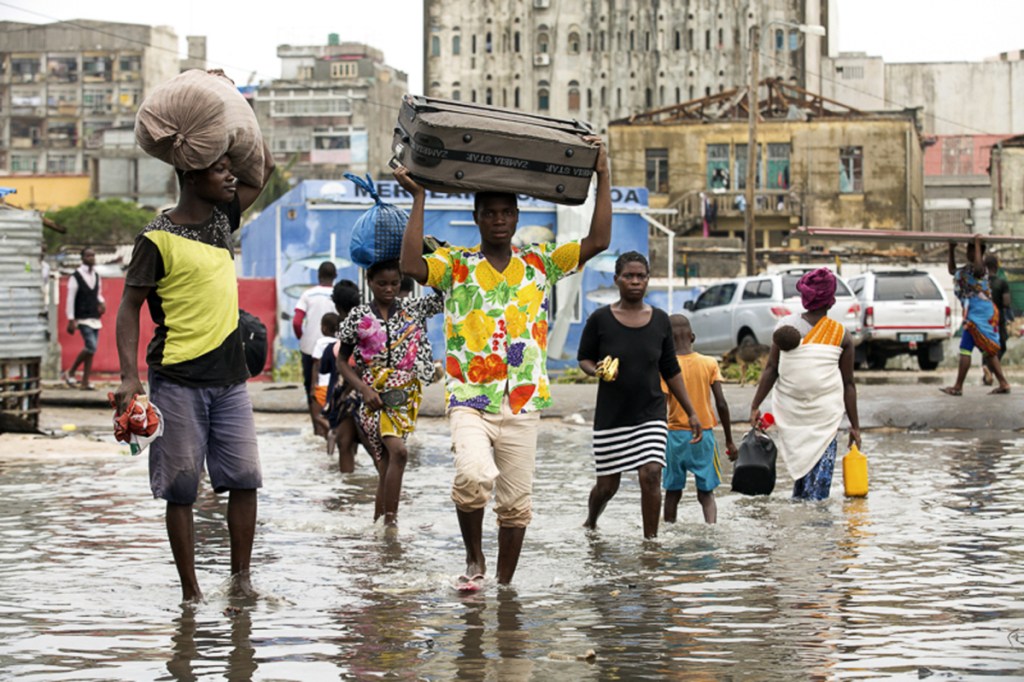NAIROBI — Government and aid agency officials sounded the alarm on Tuesday after the first flights over a vast area of wreckage wrought by Cyclone Idai in Zimbabwe, Malawi and especially Mozambique spurred fears of a massive human toll.
Five days have passed since the powerful storm landed a direct hit on Mozambique’s fourth-largest city, Beira, which was almost totally destroyed. The city and its surrounding coastal plain were submerged by a storm surge that was reported to be over 18 feet high in some places. Continued torrential rain has only intensified the flooding and complicated efforts to save thousands of stranded people.
The official toll is already in the hundreds across the three southeast African countries. After an aerial tour of Beira’s surroundings, Mozambique’s president told state radio Monday that deaths in his country could surpass 1,000.
“Everything is destroyed, everything,” said Deborah Nguyen, a World Food Program official. “When I got here on Sunday, you could see the tops of palm trees in rural areas. Now it is just an inland ocean. The rain isn’t stopping anytime soon.”
Footage showed miles and miles of submerged areas, both rural and urban. The Red Cross estimated that 90 percent of the buildings in Beira, a port city of half a million people, were damaged or destroyed. The storm made landfall with sustained winds equivalent to a Category 2 hurricane in a region with weak infrastructure.
One of the few areas in Beira that remain above the floodwaters, the city’s airport, became a staging ground for humanitarian relief efforts. On flights over the city and surrounding areas, aid workers said, they saw hundreds of people crammed onto rooftops, in the branches of palm trees and on small hillocks, waiting to be rescued. But aid workers also said most rooftops had been ripped off by the storm’s winds.
Heavy rains are expected to continue through the week. The United Nations estimated that more than 2.5 million people need immediate assistance. And with the crops and homes of thousands of families destroyed, a prolonged humanitarian crisis appeared inevitable.
“We are saving people one by one,” said Caroline Haga, an official with the International Federation of the Red Cross. “Nobody was expecting this, so we are catching up. The first flyovers of rural areas were only yesterday. We are looking into bringing boats.”
Planeloads of fortified porridge and biscuits were arriving from around the region, and from aid agency warehouses in Dubai and Nairobi.
“There’s a sense from people on the ground that the world still really hasn’t caught on to how severe this disaster is,” Matthew Cochrane, a spokesman for International Federation of Red Cross and Red Crescent Societies, told a U.N. briefing in Geneva.
Idai was particularly deadly because of its slow, meandering route. The storm made landfall in Mozambique twice – first as a tropical depression bringing heavy downpours, and then 11 days later it returned after strengthening in the warm waters of the Mozambique Channel.
The first landfall killed more than 120 people in Malawi where drought conditions gave way to flooding. Malawi’s government has reported 56 additional deaths since Idai made landfall.
When Idai barreled onto land a second time, it brought extreme rainfall to the mountainous border region between Mozambique and Zimbabwe. Zimbabwe’s government has announced 98 deaths related to the cyclone, including many in rock and mudslides. Social media users shared footage of rampaging rivers that had washed away roads, bridges and homes. Local media reported that many had been sleeping outdoors in the mountains since Friday.
The storm’s drenching bands stretched so far that around 10 deaths were attributed to the storm in South Africa and Madagascar as well.
The region affected by Idai is one of the poorest in the world. Infrastructure was already lacking, and the storm has destroyed key public institutions like hospitals and water sources. The United States government has given billions of dollars to Mozambique, Malawi and Zimbabwe in economic assistance over the past decade.
Zimbabwe’s treasury released $18 million to rebuild after the storm. The country relies on the port in Beira for some of its fuel imports, adding to fears that a preexisting fuel shortage would worsen. The pipeline was not thought to be damaged, but the port remained closed.
Beira is a key entry point for food and other goods for central Mozambique, as well as Zimbabwe and Malawi, which are both landlocked.
Copy the Story LinkSend questions/comments to the editors.



Success. Please wait for the page to reload. If the page does not reload within 5 seconds, please refresh the page.
Enter your email and password to access comments.
Hi, to comment on stories you must . This profile is in addition to your subscription and website login.
Already have a commenting profile? .
Invalid username/password.
Please check your email to confirm and complete your registration.
Only subscribers are eligible to post comments. Please subscribe or login first for digital access. Here’s why.
Use the form below to reset your password. When you've submitted your account email, we will send an email with a reset code.